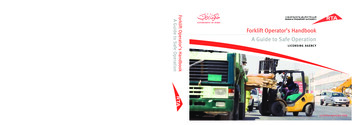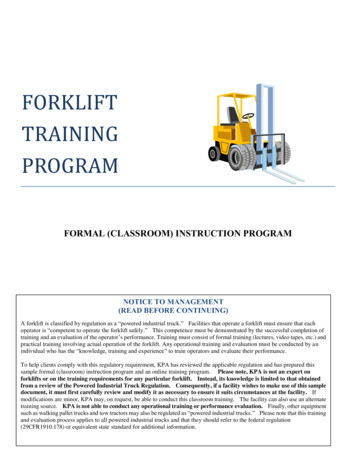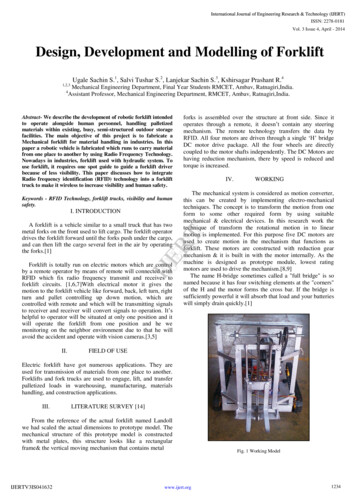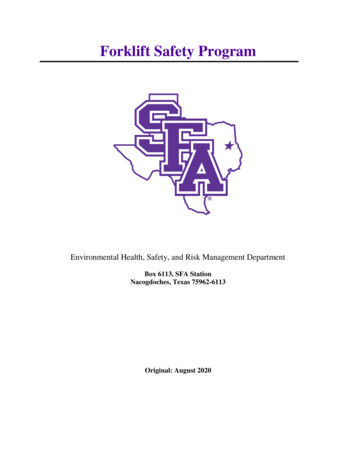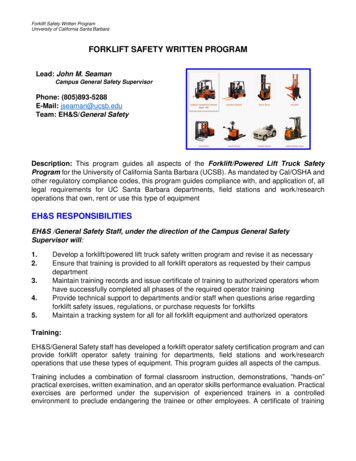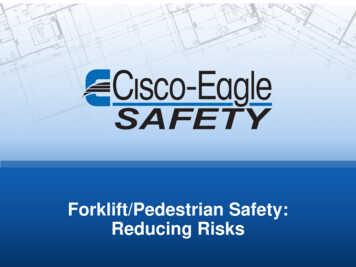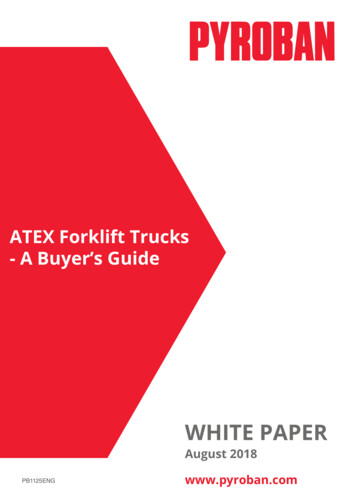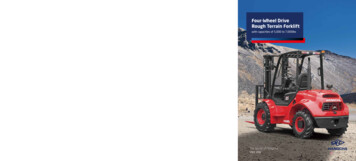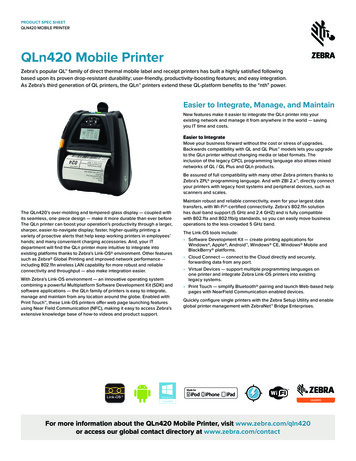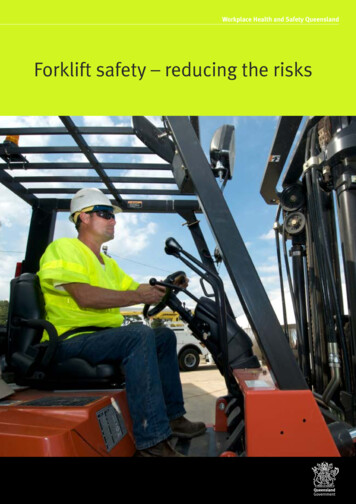
Transcription
Workplace Health and Safety QueenslandForklift safety – reducing the risks
ContentsIntroduction.3Forklift dangers. 3About this guide. 3Legal responsibilities.4Employers: reducing the risks. 4Employees: reducing the risks. 4Qualifications and training. 4Training. 4Consultation.5Manufacturers and suppliers: reducing the risks. 5Physical hazards and safety issues.6Instability. 6Speed and stopping distances. 7Sprains and strains. 8Slips, trips and falls. 9Attachments. 9Operation and maintenance.10Check the forklift before you start. 10Check the workplace before you start . 10Get on and off safely. 11Operate the forklift safely . 11Carrying and handling loads safely. 13Maintain the forklift. 15Supporting systems.16Traffic management plans. 16Policies and safe work procedures. 18Incident reporting . 19Selecting a forklift . . 19Contacts and acknowledgements.20Local workplace health and safety authorities. 20Acknowledgements. 20DisclaimerThis information is for guidance only and is not to be taken as an expression of the law. It should be read in conjunction with the relevant legislation.For more information contact your local workplace health and safety authority.This publication was developed by SafeWork South Australia 2010. It has been reviewed and endorsed by Workplace Health and Safety Queensland.For specific Queensland occupational health and safety requirements, refer to the: Work Health and Safety Act 2011 Work Health and Safety Regulation 2011.AEU18/5997Forklift safety — reducing the risks 2
IntroductionIn warehouses, factories, shipping yards, freight terminals and other workplacesacross Australia, forklifts are used to lift, stack and transfer loads.While forklifts offer a practical materials handling solution for many businesses, eachyear they continue to be associated with workplace deaths and injuries.The human and financial cost of forklift-related incidents for employees, industry andthe community is substantial.However, forklift incidents can be prevented, especially when employees andemployers work together to improve health and safety at work.This document seeks to improve health and safety outcomes in Australian workplacesby offering businesses and employees practical guidance on managing risks related toforklifts.Forklift dangersAs forklifts must be manoeuvrable they are designed to be compact, but when carrying loads they can become unstableunder certain circumstances. Fully laden, a standard two tonne forklift can weigh approximately five tonnes in total. Withlower stability, and greater manoeuvrability combined with uncontrolled traffic areas in workplaces you’ll understand whyforklifts are involved in so many incidents.Even at low speeds, forklifts can cause serious injuries and fatalities.It’s not just the employee using the forklift who can be injured; pedestrians can be crushed against a wall or an object oranother vehicle.Don’t wait until there’s an injury or death at your workplace before developing a safe system of work to control risks.About this guideSimple safe practices such as observing speed limits, stop signs, wearing correctly fitted seat belts, slowing down andsounding the horn at an intersection can make a big difference.Having a safe work environment, effective employee training, well-maintained machinery, a traffic management plan,policies and procedures and effective supervision all help reduce the risk of forklift-related injuries.This publication focuses on simple safety practices and involvement of everyone in the workplace to help reduce the riskof forklift-related injuries.This guide has four sections, covering: responsibilities of employers, employees and others physical hazards and safety issues related to forklifts (e.g. instability and body strain) practical and safe ways to operate your forklift (e.g. carrying loads and maintaining the forklift) supporting workplace systems (e.g. traffic management plans and incident reporting).3 Forklift safety — reducing the risks
Legal responsibilitiesEmployers: reducing the risksYou are responsible for providing: a safe work environment safe systems of work safe and well-maintained machinery proper information, training and supervision.Combined with the four SAFE Steps of hazard management (see pages 15 and 16) and an effective traffic managementplan, these measures can help reduce the risk of forklift-related injuries.This guide contains suggested checklists and practical information to help you do this.Choosing a safe forklift is one of the most obvious ways to reduce the risk of a forklift-related injury.If you’re about to buy or hire a forklift, see ‘Selecting a forklift’ on page 18.Employees: reducing the risksYou have responsibilities. You must: work with your employer and co-workers to improve safety comply with reasonable instructions, training and information given, and follow safe work procedures to do your work not put yourself or your co-workers at risk report accidents, near misses and hazards (including unsafe equipment) to your employer or supervisor andemployees’ safety representative use protective equipment correctly.This guide contains suggested checklists and practical information to help you do this.Qualifications and trainingTo operate a forklift you must be trained and hold a relevant qualification. In some states and territories you are alsorequired to hold a licence to operate a forklift. Check with your local workplace safety authority (see page 19) forrequirements in your state or territory.TrainingRecords of training (a logbook) must be maintained while you train.The operator should be competent to operate a forklift in the particular environment in which they are required to work.Specific skills require additional training (e.g. gaining your qualification is based on general forklift use with a standardmast, but where attachments are used, further supervision and training are required).QualificationsIndependent authorised assessors will evaluate skills against a national instrument of assessment.Having a qualification indicates you have the knowledge and skills to operate a forklift without danger to yourself orothers.Wherever you operate in Australia, a standard age limit applies. A person wishing to be assessed for operation of a forkliftmust have attained the age of 18. Contact your local workplace health and safety authority for details.If you are an unqualified trainee, you must operate a forklift under direct supervision and be within sight and hearingrange of an appropriately qualified forklift operator or assessor who holds the relevant qualification.When you operate and/or drive a forklift on a public road, you must hold a current driver’s licence.Forklift safety — reducing the risks 4
What employers must doYou must provide site-specific and refresher training to maintain and enhance your employees’ skills.You must ensure employees receive familiarisation training for any new forklift (it may have different controls or varyingattachments).Induction training for new or changed work environments, traffic management plans, policies and safe work proceduresare also a must.Maintain a register of licensed forklift operators. Make sure all contractors and any other persons using a forklift at yourworkplace hold the relevant forklift licences.If your operators are required to use purpose-designed attachments, ensure they have received sufficient instruction andtraining.Ensure training manuals and manufacturers’ information are available to your employees.ConsultationTo ensure your workplace is safe and healthy, employers, employees, managers, contractors and visitors mustcommunicate with each other and work together.As an employer, a good place to start is with employees who use forklifts, as they have first-hand knowledge of anyassociated safety issues.Involve your employees’ safety representative and your health and safety committee.By tapping into their knowledge, solutions are more likely to be practical, accepted and adopted. In turn, your worksite ismore likely to reduce forklift-related injuries and make your workplace safer and healthier.You should consult: when identifying the specific hazards and assessing the risks associated with the forklifts in your workplace as you develop a traffic management plan before implementing any action to control the risks before making any change to the worksite before you buy or hire any equipment once solutions have been implemented to ensure they are effective and practical.Everyone in the workplace is responsible for workplace health and safety.Manufacturers and suppliers: reducing the risksManufacturers and suppliers need to provide information to workplaces about a forklift’s capabilities and limitations.Manufacturers should eliminate risks posed by forklifts during the design process. An example is introducing andpromoting intelligent systems, such as making it impossible to start the forklift unless the seatbelt is fastened.Suppliers or importers must provide information on: any hazards associated with forklifts the conditions needed to ensure operators use forklifts correctly and safely the correct and safe use of any attachments supplied specifically for a workplace any specific workplace conditions the forklift was supplied to meet.If you hire out forklifts, ensure: each forklift is fit for the intended purpose for which it was designed, and is safe to use each forklift is maintained according to the manufacturer’s specifications people hiring a forklift are appropriately licensed and know how to use it safely.5 Forklift safety — reducing the risks
Physical hazards and safety issuesInstabilityTipping over is the biggest danger for an employee using a forklift. If an employee jumps from an unstable forklift, thechances of serious harm are high.A forklift can tip over by rolling or overturning sideways, or by pitching forward when the back wheels lift off the ground.Forklifts can tip over if you: accelerate quickly in reverse brake too quickly, especially on a loaded forklift brake or accelerate while cornering brake or accelerate down a slope carry a load facing down a slope carry an unevenly balanced load collide with another vehicle drive across inclines or uneven ground such as potholes (particularly with a height difference greater than20mm across the front wheels) drive with the tines raised too high (loaded or unloaded) strike low doors or overhead structures turn too fast tow without using the designated tow point.Most tip over incidents involve unloaded forklifts, which are more unstable than a loaded forklift withthe load carried low.Forklift stability: key practical issues To avoid a forklift tipping over, the most important specifications to consider are lift capacity, the maximum loadsupported, and vertical lift travel. When stationary at the rated load and with the load down, forklifts have a stability safety margin of 30–50 per cent. For a fully elevated load with a vertical mast, the stability safety margin is reduced to 15–20 per cent. While stacking with off-centre loads at full height — on a surface with a two per cent difference in gradient(20mm in one metre) — stability can be significantly affected. Loads suspended from a jib attachment on a forklift make it more likely to tip forward when braking. When making lifts over four metres, a dual wheel forklift should always be used to improve stability.What employers can do Do a risk assessment where you will be working, to determine a suitable forklift. Get the manufacturer’s information about your forklift’s limitations including:– operation on uneven surfaces and inclines –the effect of different tyre types on stability–capacities at different lift height and positions–how the limiting capacity was determined.When commissioning a new forklift, adjustments can be made to mast lift cylinders to prevent overloading. The maximum hydraulic pressure should be set at about 110 per cent of the rated load at full height with themast vertical.Forklift safety — reducing the risks 6
Forklifts are often supplied with a model number painted on the side, which can be mistaken for the forklift’soperating capacity. Make sure operators use the load capacity data plate, and don’t assume the forklift’s capacity from these markings. Ensure seatbelts are correctly fitted and worn (e.g. by installing intelligent systems, the forklift can only bestarted if the seatbelt is fastened). Seatbelts may be retro-fitted. Buy or hire forklifts with speed-limiting devices, load-weighing devices and other stability-enhancing features. Be aware that productivity incentives may encourage your employees to drive and work too quickly which canincrease the risk of incidents. Implement traffic control measures that account for the risks in the workplace, to reduce the risk of instability.See ‘Traffic management plans’ on page 15. Reduce the speed limit at your workplace. Ensure all forklifts are appropriate for the workplace. Buy or hire forklifts with a slightly greater load capacity than you actually need. Do your research and get a safe and fully compliant forklift for your money.What employees can do Drive safely. See ‘Operate the forklift safely’ on page 10 for information.To ensure your own safety, and that of others, always operate forklifts safely.However, if tipping occurs you should: stay in the cabin with the seatbelt on brace yourself with your feet pressing down and your arms pushing you back into your seat stay with the forklift and lean in the opposite direction of tipping.Jumping from an overturning forklift often results in death. While seatbelts might be considered a nuisance, they can alsobe a lifesaver.Speed and stopping distancesApplying a forklift’s brakes inappropriately can cause the forklift to tip forward or lose its load. The workplace environmentalways needs to be considered.Speed limitsYour hazard management process (see ‘Develop your traffic management plan’ on page 15) will determine the speedlimits appropriate to your workplace. Consider the stability of the forklift under braking, its stopping distances andenvironmental factors.Once you’ve determined the speed limits, these should be prominently signposted. Make sure signs are placed so thatemployees on forklifts can see them easily.Make sure speed limits are observed and enforced.Buy or hire forklifts with speed limiting devices or retro-fit them to your current forklifts.Stopping distancesYou need to know stopping distances when you plan speed limits, forklift routes and your overall traffic management plan.The following table shows the typical distance it takes for a 2.5 tonne forklift to stop once the employee has applied thebrakes. This is in optimal conditions: travelling on a dry, even surface with good traction, driven by an alert employee notdistracted by other activities.7 Forklift safety — reducing the risks
Reaction distance and total stopping distance (typical reaction time: 1.5 sec)6121416182022Speed (metres/second)1.73.33.94.455.66.1Distance travelled while driver reacts and beginsto apply the brakes in an emergency 1413-16.514.5-19Speed (kilometres/hour)Total emergency stopping distance (metres)Data from the Monash University Accident Research Centre and based on a 2.5 tonne forkliftStopping distances are often significantly under-estimated.For example, even at six kilometres an hour (i.e. walking pace) a forklift needs at least three metres to stop.The distance at which a forklift can stop is affected by: the speed at which it is travelling the weight of its load its mechanical and tyre condition the road surface.A laden forklift cannot use its maximum braking capacity, because the load will slide or fall from thetines, or the forklift will tip forwards.Sprains and strainsSprains, strains and other soft tissue injuries to the neck, back and arms can cause long-term health problems.Common hazards that injure forklift drivers include: continuously and/or repeatedly looking up during high stacking continuously and/or repeatedly looking behind while reversing repeatedly hitting bumps or driving on uneven surfaces using poorly positioned or poorly maintained controls.Save money and time by choosing and maintaining a forklift with features to prevent these injuries.What employers can do Consider forklifts with swivel chairs and/or closed circuit video systems to reduce neck ‘craning’ and twisting. Ensure road surfaces are even and in good condition (maintain and repair). Ensure the forklift seat is in good condition to minimise vibration and jolting, that it supports the back and hassufficient cushioning, and that the cabin is also in good condition. Allow variety in forklift driver tasks so that they can change their posture. Check that the controls are comfortable to reach and operate. Ensure the forklift is regularly serviced and maintained including its controls and seating.Forklift safety — reducing the risks 8
Slips, trips and fallsMany forklift-related injuries involve slips, trips and falls when getting on and off.What employers can do Ensure your forklifts have:––––adequate access and egress to provide three points of contact (hands and feet) while getting on and offsteps with anti-slip surfaces and enough space to stand on firmlygrab handles or rails that allow proper grip, and are positioned in an accessible locationsuitable locations for controls and foot pedals to eliminate trip hazards Buy or hire forklifts with the above features or retro-fit them to your current forklifts. Repair or replace broken steps, rails and handles. Ensure road surfaces are in good condition (maintain and repair) and clear of debris and other obstructions. Provide a location to park the forklift that is well lit so drivers can clearly see the ground surface, and that is notmuddy, slippery, or uneven. Provide employees with information and training on the correct and safe way to get on and off forklifts. Minimise the number of times that employees need to get on and off their forklift to help reduce the number ofslips, trips and falls. See ‘Get on and off safely’ on page 10.AttachmentsAttachments include any side shift devices, jibs, extension tines and specifically designed devices forload manipulation or carrying.Using attachmentsWhen an attachment is fitted to a forklift, the dynamic and operating characteristics may change, making it necessary tode-rate the forklift capacity and restrict some operating controls.Attachments must have: rated capacities de-rated capacities due to the attachments.If an attachment is fitted, make sure you have access to information on the de-rated capacity of the forklift.Only use attachments designed for the forklift they are used on. Make sure the attachment is secured correctly and safelyon the forklift. Do not tilt the mast forward. If a load is suspended, drive slowly to avoid the load swinging, as this willincrease the forklift’s instability.Specific skills require specific additional training and supervision. Employers must ensure that where attachments areused, further training is given to forklift operators and adequate supervision is provided.Selecting attachmentsAsk the manufacturer of the attachment whether it can be used safely on your forklift.Forklift attachments must be: designed by a competent engineer manufactured by competent people safely used on the forklift.9 Forklift safety — reducing the risks
Operation and maintenanceCheck the forklift before you startBefore you start the forklift, ensure it is in safe working order, ready to be used and capable of completing the task(s)required of it.Develop and implement a system of work that nominates the person who will ensure that safety checking occurs(e.g. a manager or supervisor).Report any damage or problems to your employer, supervisor, manager or employee safety representative immediately.If any damage or problems are noticed, isolate the forklift so it cannot be used.Complete a checklist as part of your pre-operational routine (example below). This is an important part of any effectivemaintenance program. If you are using a new or different forklift, this checklist will help you become familiar with themachine.Pre-operational forklift checklistForklift operators should do the following before starting:Tyres: check all for wear or damage, and pressure (if applicable)Fluids: check oil, hydraulics, battery, fuel and coolantSeating: check the condition and adjustmentWarning devices: check lights, horns, reversing beeper and flashing lightCapacity: check that the load capacity data plate is fitted, legible and correctMast: check for signs of wear to the lift chains and guidesHydraulic cylinders and hoses: check for any leaksTines: check for excessive wear, damage, cracks or repairsSeatbelt: make sure it is in good working order (if fitted)Guarding: check that all guards are in placeOnce started:Controls: check that all pedals and controls operate correctlyBrakes: check that all (including parking brake) operate correctlyThis list is not exhaustive, and does not replace the four SAFE Steps of hazard management (see page 15).The issues identified during that process should guide you.Check the workplace before you startAn employer must provide a safe work environment. The four SAFE Steps of hazard management (see page 15)plus your traffic management plan can help you do this.If you’re an employee, check the area you’ll be working in before you start your forklift, as well as the ‘no go’ zonesfor pedestrians or forklifts.If you notice any problems, report them to your employer (or supervisor or manager) immediately.Complete a checklist like the one following as part of your pre-operational routine.Forklift safety — reducing the risks 10
Pre-operational work environment checklistBefore starting:YesNoAre ‘no go’ zones clearly marked with signs and fences?YesNoIs there sufficient lighting and ventilation for you to work safely?YesNoIs there a lot of noise (from other machines) that may impair your ability to hear?YesNoAre road surfaces even and clear of obstructions? (Are there features such as ramps and rail tracks?)YesNoAre there overhead features such as low doorways, fittings, cables and power lines?YesNoAre there any other obstructions?YesNoAre there wet and dry areas? (Any spills?)YesNoAre loading docks clear? (Do they have edge protection?)YesNoIs there sufficient room or capacity on storage racking?YesNoAre forklift operating paths clear? (Are they wide enough?)YesNoAre there any congested areas?YesNoAre there any blind spots?YesNoIs there any interaction with pedestrians or other traffic?This list is not exhaustive, and does not replace the four SAFE Steps of hazard management (see page 15). The issuesidentified during that process should guide you.Get on and off safelyAround a quarter of all forklift-related injuries occur when an employee gets on or off.What employees can do Lower the tines to ground level, ensure the parking brake is set, and the controls are in neutral. Don’t jump from your forklift. Face the forklift and maintain three points of contact (hands and feet) when you geton and off. Minimise the number of times you need to get on and off. Work and park in well lit areas so your vision of the road surfaces and other traffic (including pedestrians) is clear.Your employer should ensure all forklifts are fitted with anti-slip surfaces and grab-rails.See ‘Slips, trips and falls’ on page 8.A forklift can be one of the most dangerous pieces of equipment in the workplace.Operate the forklift safelyOnly after you’ve checked the forklift and the work environment, should you start using the forklift.Safety basics Only use a forklift for the purpose it was designed. Dangerous work practices include bumping pallets, pushing pilesof material out of the way, moving heavy objects by using makeshift connections and attachments. Wear a seatbelt (if fitted). Obey speed limits and stop signs. Drive at speeds suitable to the road surfaces and traffic conditions. Wear safety glasses or goggles to protect your eyes from dust and debris when you move stored products fromoverhead shelving.11 Forklift safety — reducing the risks
Operating basics Use extra caution and avoid turning when negotiating grades, ramps and inclines. Slow down and sound your horn before going through a doorway; before entering or crossing a main aisle andapproaching an intersection or corner (especially blind corners). Always travel at a safe distance behind another forklift or other vehicles. When moving, tines should be just below axle level or at a safe height. Be aware of blind spots created by the mast and other parts of the forklift. Even small parts may block out large areasof your view of the workplace. Don’t reach through the mast or place parts of your body outside the forklift while its in operation.People Do not carry passengers unless the forklift is designed to carry more than one person. An additional seat, footrest andseatbelt should be provided. Do not raise people on tines or pallets. Do not allow anyone to stand, work or walk under raised tines. Be conscious of people working around you (e.g. tail end swing). Do not allow people to walk beside you while youare using the forklift.Work environmentSee also ‘Check the workplace before you start’ on page 9. Do not drive over spilt liquids or powders as this reduces the traction of the tyres and spreads the substance, causingproblems for other traffic. Remove hazards or obstructions from the floor rather than drive around or over them. (Report any dangerous surfaceconditions to your supervisor immediately.) Be aware that driving from a wet to dry surface or dry to wet affects tyre traction, braking and stability. Allow enough time for your eyes to adjust when you move from dark to light areas and vice versa.Guardrails and safety harnesses Order-picking forklifts must have guardrails to prevent falls. If it is possible for someone to extend their body over the guard or step from the platform of an order-picking forklift,then a safety harness must be provided and worn. The harness must be attached to a strong anchor point by anapproved lanyard and shock absorber. Working through the four SAFE Steps of hazard management (see page 15) willhelp you determine the type of travel restraint or fall prevention system appropriate to your workplace and the workyou do. An order-picking forklift truck licence is required to operate this type of forklift.Work cages Work cages must be used to raise people performing short-term tasks and the cage must be securely attached to theforklift. (You may be required to register design-approved work cages. Contact your local health and safety authorityfor more information.) Work cages should only be attached to a compliant forklift, with a load capacity data plate stating the attachmentsthat may be used. Ensure your traffic management plan deals with tasks involving work cages. Before starting work, ensure the parking brake is set, the controls are in neutral, the mast is vertical, and all controlsare immobilised except lift and lower. Employees should be trained in the
across Australia, forklifts are used to lift, stack and transfer loads. While forklifts offer a practical materials handling solution for many businesses, each year they continue to be associated with workplace deaths and injuries. The human and financial cost of forklift-related incidents for employees, industry and the community is substantial.


